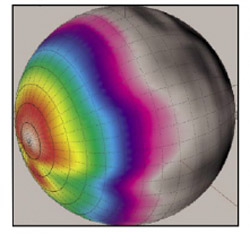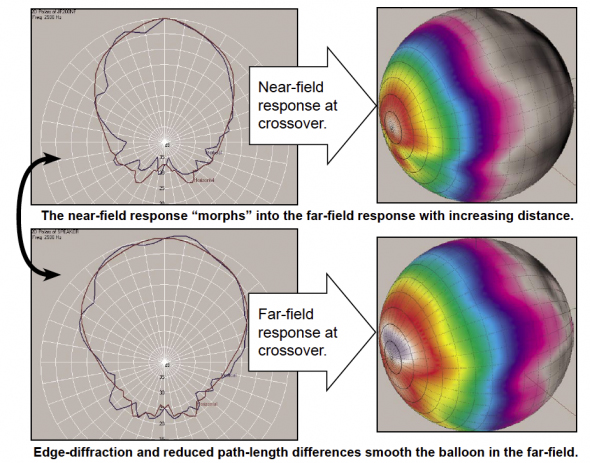
A compromise is to measure the radiation balloon of a single unit and predict the response of multiples using array modeling software.
Equally difficult are large ribbon lines and planar loudspeakers, again due to the large area from which high frequency energy radiates.
It would appear that all that is necessary is to pick a very large measurement distance. While this solves the far-field problem, it creates a few also. They include:
1. Air absorption losses increase with distance. While these can be corrected with equalization, the HF boost puts a greater strain on the DUT.
2. It becomes increasingly difficult to maintain control over climate with increasing distance (drafts, temperature gradients, etc.). These effects produce variations in the measured data, making the collection of phase data difficult or impossible.
3. Indoors, the anechoic time span becomes shorter with increasing distance, since the path length difference to the ceiling, floor, or side walls is reduced as the microphone is moved farther from the source. The effect is an increase in the lowest frequency that can be measured anechoicly (a reduction in frequency resolution).
4. Direct field attenuation will be 10 dB greater at 30 m (100 ft) than at 9 m (30 ft). This reduces the signal-to-noise ratio of the measured data by 10 dB, or requires that ten times the power be delivered to the DUT to maintain the same S/N ratio that exists at 30 feet.
5. Outdoor measurements are difficult due to unstable noise and climate conditions over the time span of the measurement (up to 8 hours).
Large measurement distances are possible if the above problems are solved. A large aircraft hanger with a time windowed impulse response represents a good way to collect balloon data at remote distances.
Our chamber at ETC, Inc. allows measurement out to 9 m (30 ft). This is an adequate distance for the majority of commercial sound reinforcement loudspeakers, but not all of them.
The loudspeaker rotator is portable, so devices that cannot be measured at 9 meters are measured in a very large space at a distance out to 30 meters. A time window provides the required reflected-field rejection. Determination of the required measurement distance is made on a case-by-case basis after considering the device-to-be-tested.
Using the above criteria for the far-field, and fixing a measurement distance of 30 feet (9 m), the highest frequency balloon possible for different size devices can be determined (Figure 3).
Note that this is the largest dimension of the HF device. If the far-field condition is met for it, it will typically be met for all lower frequencies.
The far-field prerequisite for loudspeaker attenuation balloons must be met to allow the data to be projected from one meter to listener seats with acceptable error. The condition is easily satisfied for physically small devices, i.e., bookshelf loudspeakers.
Since sound reinforcement loudspeakers are often physically large, there exists a highest frequency limitation in what can be measured at a fixed measurement distance.
Ideally, data for which the far-field criteria is not met should be excluded or marked as suspect on specification sheets or within design programs. Usually it’s not, so the user must use some intuition in HF modeling of sound coverage in auditoriums.
Pat & Brenda Brown lead SynAudCon, conducting audio seminars and workshops online and around the world. For more information go to www.prosoundtraining.com.
SynAudCon is now offering “Audio Applications – System Optimization & EQ” as web-based training. Click the link to see the related article.
More Church Sound articles by Pat Brown on PSW:
How To Illuminate The Audience With Beautiful, Consistent Audio Coverage
Ten Reasons Why Church Sound Systems Cost More
What Makes A Quality Loudspeaker?


